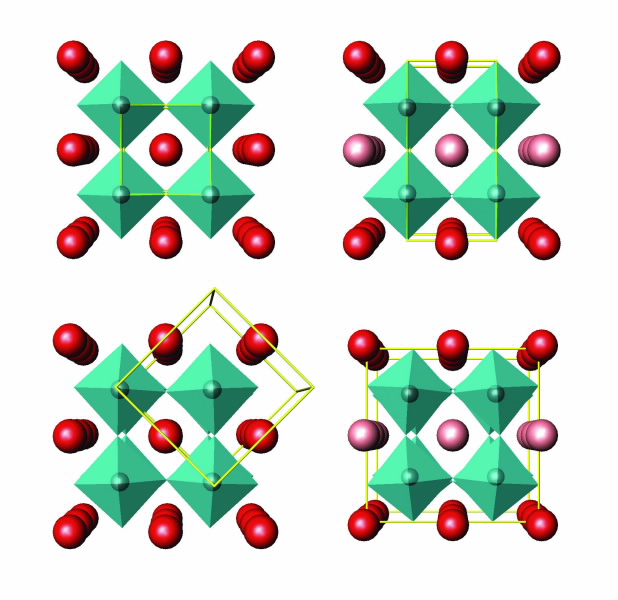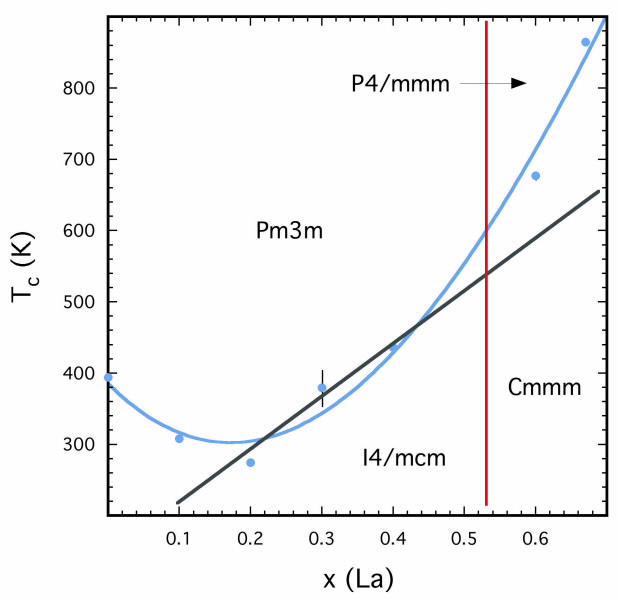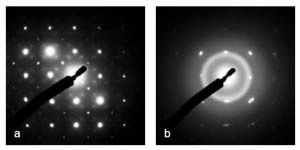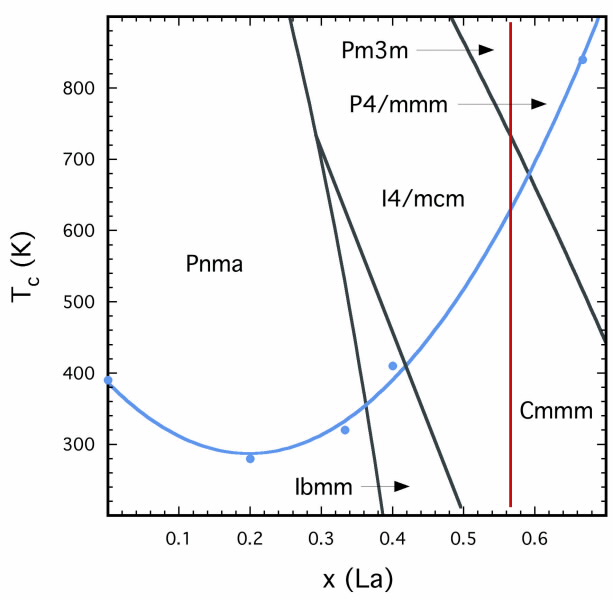All materials for future energy production using nuclear energy will need to perform under extreme levels of irradiation and elevated temperature without significant degradation of properties for a specified service life.
These advanced nuclear materials represent a material’s life cycle and include structural load-bearing materials, radiation barriers, inert matrix fuels, transmutation targets, and specialised waste forms.
Our research investigates radiation damage in complex perovskite systems, where we test a theory that a coupling exists between the radiation damage recovery mechanism and a phase transition in the LaxSr1-1.5xTiO3 system.
Why perovskite?
Many of the physical and chemical properties of high technology materials depend critically on the nature and concentration of defects. In crystalline solids, the types of defects present include point defects (e.g. vacancies and interstitials), impurity atoms, and extended defects (e.g. edge and screw dislocations).
In this work, we are mainly concerned with materials that must perform a specific function while being exposed to external irradiation, e.g. inert matrix fuel materials, transmutation targets, and nuclear waste forms.
The compound perovskite, with the ideal general formula ABO3, encompasses a large family of compounds with large A cations (e.g. La) and small B cations (e.g. Sr or Ca), but it also has a number of different structural phases and subsequent phase transitions that occur with changes in temperature.
Perovskite is important as a component of high-technology devices and may also incorporate trivalent fission products (e.g. Ce, Nd, Pr) and actinides (e.g., Pu) on the A-site, making it very attractive in the field of nuclear science and technology.
The nature of the defects produced in these materials is related to the mass and energy of the irradiating particles and the ability of the solid to recover from structural damage (radiation tolerance).
However, crystal structure, composition, and the presence of pre-existing cation vacancies (unoccupied sites) also play an important role in the recovery from radiation damage. Some materials actually “heal” themselves very quickly during irradiation and remain crystalline to very high dose levels.
Combining both experimental and atomistic computer-simulation approaches – a truly multidisciplinary effort – we can describe changes in radiation response as a function of composition and temperature.
This article is in essence a three-part story in which we describe unusual radiation response in Sr-La perovskites, apply computer simulations to understand the problem at the atomic scale, and then attempt to determine if damage recovery is related to a well-known structural phase transition.
 |
| Perovskite structures obtained in the system LaxSr 1-1.5x TiO3. In each structure, the Ti atoms are surrounded by six oxygen atoms, forming an octahedral coordination environment. The two structures on the left, Pm3m (a) and I4/mcm (c), exist for compositions with less than 0.53 La atoms (to the left of the vertical red line in Fig. 2). Red spheres represent Sr, La, and vacancies (disordered in these two structures). The two structures on the right, P4/mmm (b) and Cmmm (d), exist for compositions with more than 0.53 La atoms (to the right of the vertical red line in Fig. 2). In these structures the Sr and La atoms (red spheres) and vacancies (pink spheres) are ordered into alternating layers. Phase transitions (black line in Fig. 2) between thestructures in the upper (a, b) and lower structures (c, d) are due to tilting of the octahedra. |
Structure and radiation tolerance in complex perovskites
At first, we attempted to understand the radiation damage response of perovskite compounds with A-site vacancies in the system LaxSr1-1.5xTiO3 [1]. This system is of interest because the replacement of Sr by La requires some vacancies, e.g. for every three Sr atoms, two La atoms and one vacancy are required to maintain charge balance.
Fig. 1 (illustrated in the image library below) shows the four different crystal structures we found in this system and Fig. 2 shows the stability field for each structure over a range of temperature (vertical axis) and composition (horizontal axis). The diagonal black line in Fig. 2 represents the boundary between structures due to octahedral tilting and the vertical red line at x = 0.53 is the boundary due to (Sr, La)-vacancy ordering.
The two structures at the top of Fig. 1 (a and b) occur above the gray line in Fig. 2, the octahedra in these structures (Pm3m and P4/mmm) are not tilted.
Conversely, the two structures at the bottom of Fig. 1 (c and d) occur below the gray line in Fig. 2 and the octahedra in both structures (I4/mcm and Cmmm) show the tilting characteristic of many perovskites.
|
| This figure shows a portion of the system LaxSr1-1.5xTiO3, [1], wherein we show how the critical temperature for amorphisation (Tc) changes with increasing La and vacancy content (indicated by the blue symbols and curve). Near coincidence of the blue data points for x = 0.2, 0.3, and 0.4 suggests the possibility of a link between the octahedral phase transition (black line) and the damage recovery mechanism. Remember that in these perovskites, one vacancy and two La atoms are introduced for every three Sr atoms. These measurements were obtained by ANSTO researchers at the IVEM-Tandem User Facility, Argonne National Laboratory. |
For any composition in the system, if you change the temperature above or below the black line, then the structure will change due to minor changes in the positions of the oxygen atoms – they control the tilting of the octahedra. The ordering of Sr, La, and vacancies into layers is purely down to composition and does not change significantly with temperature.
A major question facing our team was: how does the radiation response change as a function of structure and composition in this complex system?
Smith et al. [2] provided an answer to the question above by irradiation of synthetic perovskite samples with 1.0 MeV Kr ions using the IVEM-Tandem User Facility at Argonne National Laboratory.
All of the samples examined pass through the crystalline-amorphous transformation, as shown by the electron diffraction patterns in Fig. 3.
The unirradiated sample reveals the diffraction pattern of the undamaged structure (Fig. 3a), whereas the irradiated samples reveal the transformation from the crystalline to the amorphous state with increasing radiation dose (Fig. 3b-d).
When this transformation is studied as a function of temperature, we can describe radiation tolerance by an important parameter known as the critical temperature for amorphisation, Tc, which is the temperature above which the material remains crystalline due to thermal annealing of damage. In Figure 2, the blue curve shows how Tc changes with composition, with the lowest Tc being recorded at x = 0.2, the most radiation resistant composition in the system.
However, the most interesting observation is the non-linear change in Tc in the LaxSr1-1.5xTiO3 perovskite system between x = 0.0 and 0.67. At this point in the research project, we faced a major problem in trying to explain why the radiation tolerance changes the way it does.
|
| A set of electron diffraction patterns [2] illustrating the change in structure from crystalline to amorphous with increasing ion radiation dose from (a) to (d). The critical dose for amorphisation is determined by the disappearance of Bragg diffraction spots, e.g., this sample becomes amorphous at a dose bracketed by (c) and (d). This experimental procedure is repeated at different temperatures in order to determine the critical temperature for amorphisation. Diffuse rings in the diffraction patterns are due to the scattering of electrons by atoms in the amorphous structure. |
The influence of electrostatic and strain energy on defect behaviour
In order to understand the LaxSr1-1.5xTiO3 perovskites in greater detail, Thomas et al. [3] applied atomistic simulation methods to model the behaviour of vacancies as a function of composition. In this study, a combination of ab initio (Latin, meaning “from the beginning”, this refers to simulations based on first principles) and classical simulation techniques were used to characterise the energetics of A-site vacancy and cation interactions.
When the La content is low, the A-site interactions follow intuitive electrostatic arguments, promoting association of La ions with vacancies and dissociation of vacancy-vacancy pairs. This mechanism explains why Tc decreases and the material becomes more radiation tolerant between x = 0.0 and 0.2, e.g., the increasing number of A-site vacancies speeds up the recovery of atoms displaced by radiation damage by providing more available sites and by lowering the energy barrier for the migration of atoms through the material.
A set of electron diffraction patterns [2] illustrating the change in structure from crystalline to amorphous with increasing ion radiation dose from (a) to (d).
The critical dose for amorphisation is determined by the disappearance of Bragg diffraction spots, e.g., this sample becomes amorphous at a dose bracketed by (c) and (d).
This experimental procedure is repeated at different temperatures in order to determine the critical temperature for amorphisation. Diffuse rings in the diffraction patterns are due to the scattering of electrons by atoms in the amorphous structure.
For samples with high La content, the defect interactions are inverted due to strain forces arising from cooperative atomic relaxations and it is more energetically favourable for La atoms and vacancies to dissociate into separate layers (see Fig. 1b, d).
Although the reasons for reduced radiation tolerance at high La content are still open to debate, we believe that energy barriers for defect migration are higher in the strain-dominated region of the system (above x = 0.4).
For intermediate compositions with x = 0.2-0.4, our colleagues at the University of Cambridge suggested that there may be a coupling between the radiation damage recovery mechanism and the octahedral tilting phase transition. This hypothesis was tested during recent experiments described below.
|
| This figure shows a portion of the system LaxCa1-1.5xTiO3 [4], showing the phase transformation boundaries due to octahedral tilting (black lines), the cation-vacancy ordering transformation (vertical red line near x = 0.57), and the critical temperature for amorphisation (blue line). Note that in this system, the Tc curve is similar to that shown in Fig. 2 and it crosses all of the phase boundaries, therefore there is no direct coupling of any phase transformation with the damage recovery mechanism in this system. |
Ion irradiation of Ca-La perovkites – the final chapter?
Zhang et al. [4] found that the system LaxCa1-1.5xTiO3 has very different octahedral tilting transitions and two additional structures for x < 0.5, Pnma and Ibmm, both of which have tilted octahedra, although the La-vacancy ordering transition is still present at a slightly higher La content (Fig. 4).
Therefore, we chose this system as a test of the proposed coupling between radiation damage recovery and phase transition boundaries. Results of ion-irradiation experiments obtained in December 2010 on selected samples are shown in Fig. 4, where it is obvious that the Tc curve (blue line) mimics that found in the Sr-La system, but it cuts across all of the phase boundaries, thus providing evidence against the idea that damage recovery processes couple with phase transitions.
Materials related to the energy life-cycle Figure 4 In future work, we will attempt to measure the ionic conductivity in both perovskite systems, as it may give a general indication of the barriers to atomic migration (e.g., higher ionic conductivity is related to lower migration barriers).
Authors
Greg Lumpkin, Kath Smith, Bronwyn Thomas, Zhaoming Zhang, and Karl Whittle
ANSTO
References
- Howard, C. J., Lumpk
- in, G. R., Smith, R. I., & Zhang, Z. (2004). Crystal structures and phase transition in the system SrTiO3–La2/3TiO3. Journal of Solid State Chemistry, 177(8), 2726-2732.
- Smith, K. L., Lumpkin, G. R., Blackford, M. G., Colella, M., & Zaluzec, N. J. In situ radiation damage studies of LaxSr1−3x/2TiO3 perovskites. Journal of Applied Physics, 103(8), 083531.
- Thomas, B. S., Marks, N. A., & Harrowell, P. (2006). Inversion of defect interactions due to ordering in Sr1−3x/2LaxTiO3 perovskites: an atomistic simulation study. Physical Review B, 72(21), 214109.
- Zhang, Z., Lumpkin, G. R., Howard, C. J., Knight, K. S., Whittle, K. R., & Osaka, K. (2007). Structures and phase diagram for the system CaTiO3–La2/3TiO3. Journal of Solid State Chemistry, 180(3), 1083-1092.
Published: 27/05/2011





